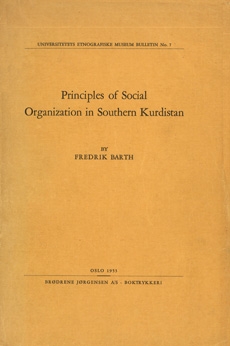
Principles of Social Organization in Southern Kurdistan
Fredrik Barth
Brødrene Jørgensen A/S - Boktrykkeri
Scattered over the South Kurdish countryside are a great number of small, compact villages, essentially similar in their physical aspects, yet highly variegated with respect to their composition and organization, ranging from extended lineage organizations to fully developed feudal organization. Thus, on the village level, there is a great diversity of forms of social organization. Yet the culture of the area seems essentially uniform, and these alternative principles of organization are universally known. In the recent history of some villages, there has been a rapid, fundamental change from one type of social organization to another. In the following, an attempt will be made to discuss these various types of organization as they express themselves in the actual power hierarchy of individuals in the village. The discussion will thus be directed towards discovering what types of social categories exist, what actual powers each category entails, and which of these categories are found in harmoneous conjunction — since some of the categories that belong in different basic frameworks of social organization are, as might be expected, mutually exclusive in any local community.
..... | 